Physical Address
304 North Cardinal St.
Dorchester Center, MA 02124
Physical Address
304 North Cardinal St.
Dorchester Center, MA 02124
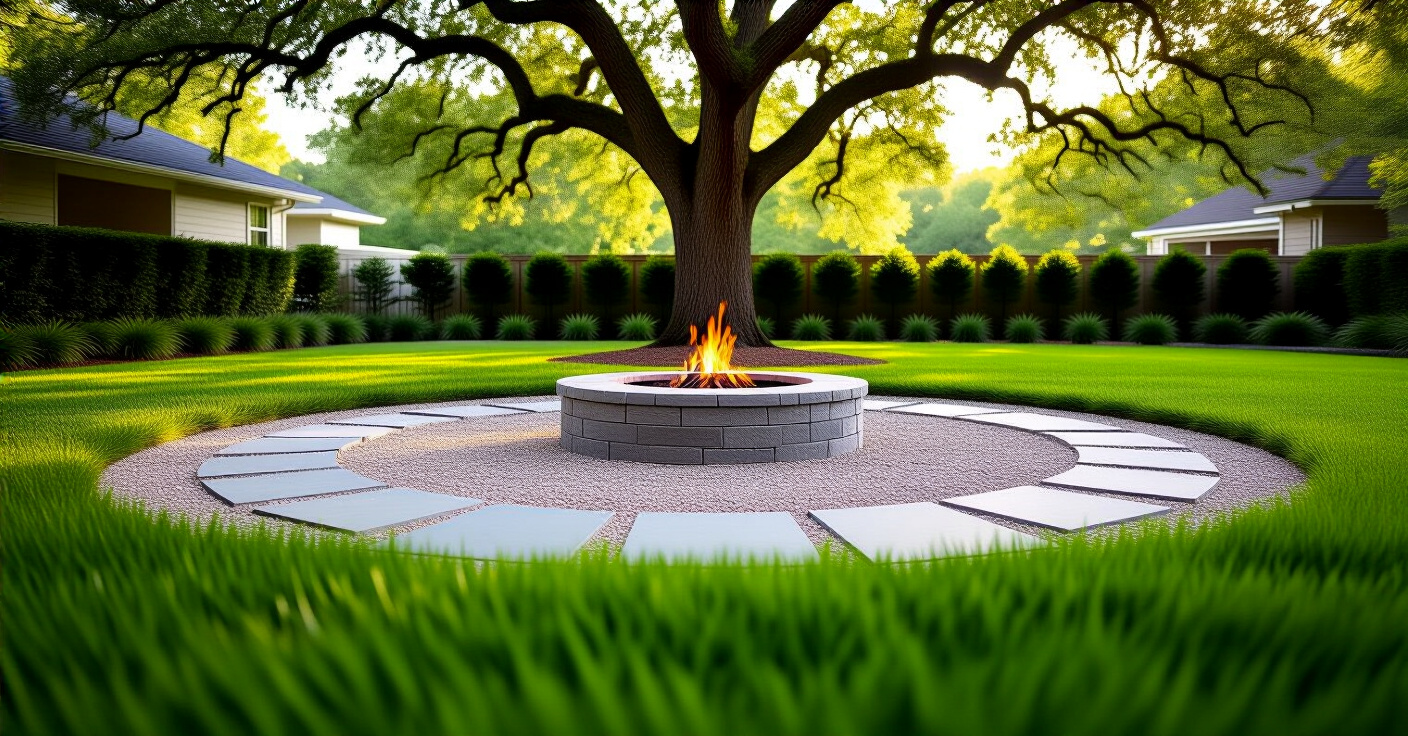
Discover 19 inspiring firepit backyard ideas to create a literary oasis. This guide covers planning, design, and safety for your perfect outdoor hearth.
Picture this: You’re turning the final, satisfying page of a book that has held you captive for days. The house is quiet. Instead of just placing it on the shelf, you carry that lingering world of ideas with you, out the back door, into the cool twilight. You settle into a comfortable chair as a low flame flickers to life, not in a grand fireplace, but in a simple stone circle at the center of your garden. This is the oldest form of gathering, the original library—the hearth, where stories were first told and shared.
You have a library that reflects your inner life, a carefully curated collection of thought and narrative. Yet, I’ve noticed that for many of us who live in books, our outdoor spaces often feel… untranslated. They lack the same intentionality, the same soul. The secret to bridging this gap isn’t just adding a feature like a fire pit; it’s about conceiving of that fire pit as an outdoor study, a place for contemplation and conversation, an extension of your library under the stars. This isn’t just a guide to backyard décor. It’s a way to build a space for the stories yet to be read, and the stories yet to be told.
Every great story begins with structure and a clear understanding of the setting. Before we dream of flickering flames and evenings of debate, we must tend to the prosaic but essential work of planning. Think of this phase as building the shelves before you acquire the books; it ensures the entire endeavor is sound, safe, and built to last.
I often tell my clients that a home library’s greatest enemy is not neglect, but elemental forces—sunlight, damp, and, of course, fire. The same reverence we hold for protecting a rare first edition must be applied, magnified, when we intentionally bring fire into our personal spaces. A site assessment isn’t a mere suggestion; it’s the foundational chapter of this story, ensuring it doesn’t end in tragedy.
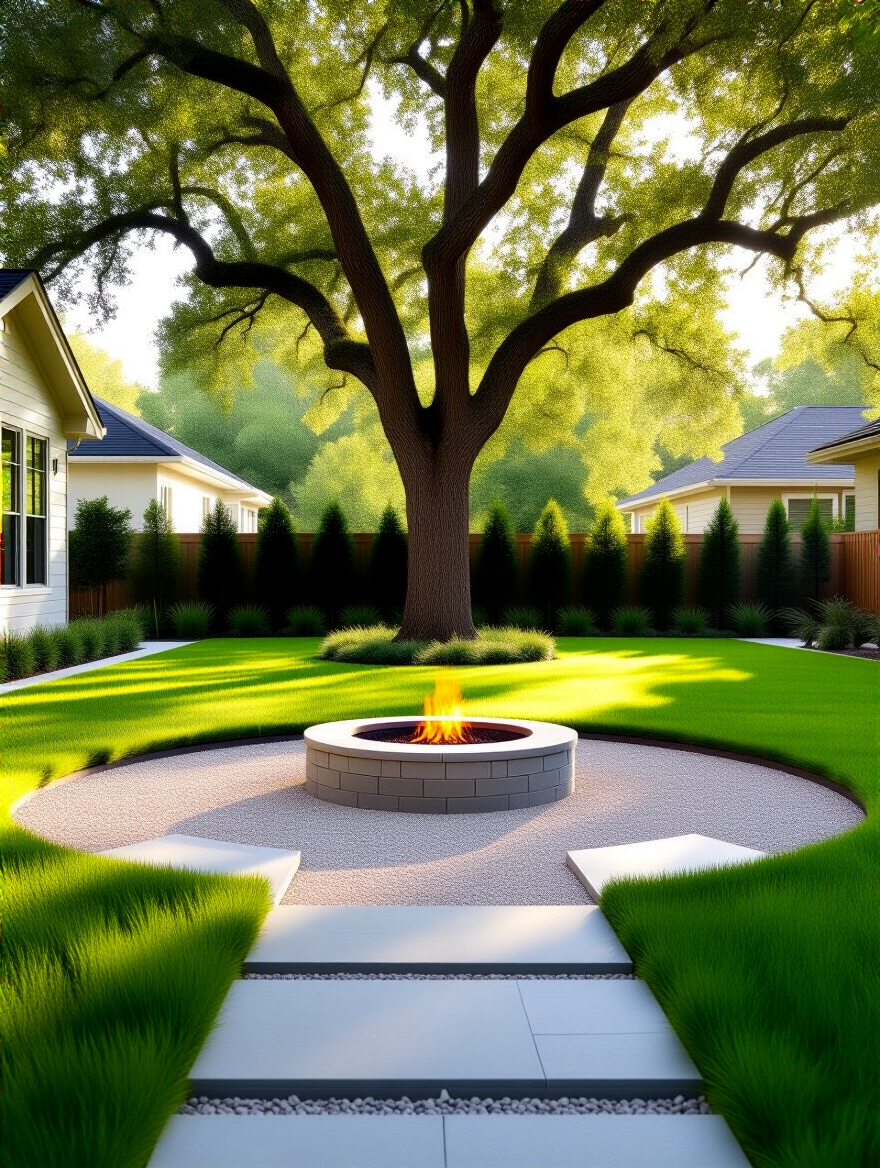
Before you do anything else, pace out a ten-foot circle from your intended spot. This is your sanctum. Nothing flammable can live here—not the deck, not the shed, not even a pile of dry leaves. Then look up. Low-hanging branches are a poetically bad idea, as they can easily catch an errant spark. A client of mine once learned this the hard way, mesmerized by the way the firelight danced on the leaves of their old oak tree, right up until the moment a leaf caught fire. The ground beneath the pit must be non-combustible—stone, gravel, pavers. Fire on a wooden deck is like storing parchment next to a candle; it’s simply tempting fate.
This initial assessment is the unglamorous but most critical part of the process. Once you’ve established a safe perimeter, you can begin to truly design with peace of mind, knowing your story won’t be a cautionary tale.
Bureaucracy is, I admit, the dullest prose. Reading municipal codes can feel like slogging through a dense academic text with no narrative payoff. But can we talk about why so many people get this wrong? They assume that because they see fire pits on television or in magazines, the rules are universal. They’re not. And ignoring the fine print can lead to a plot twist involving fines and deconstruction orders.
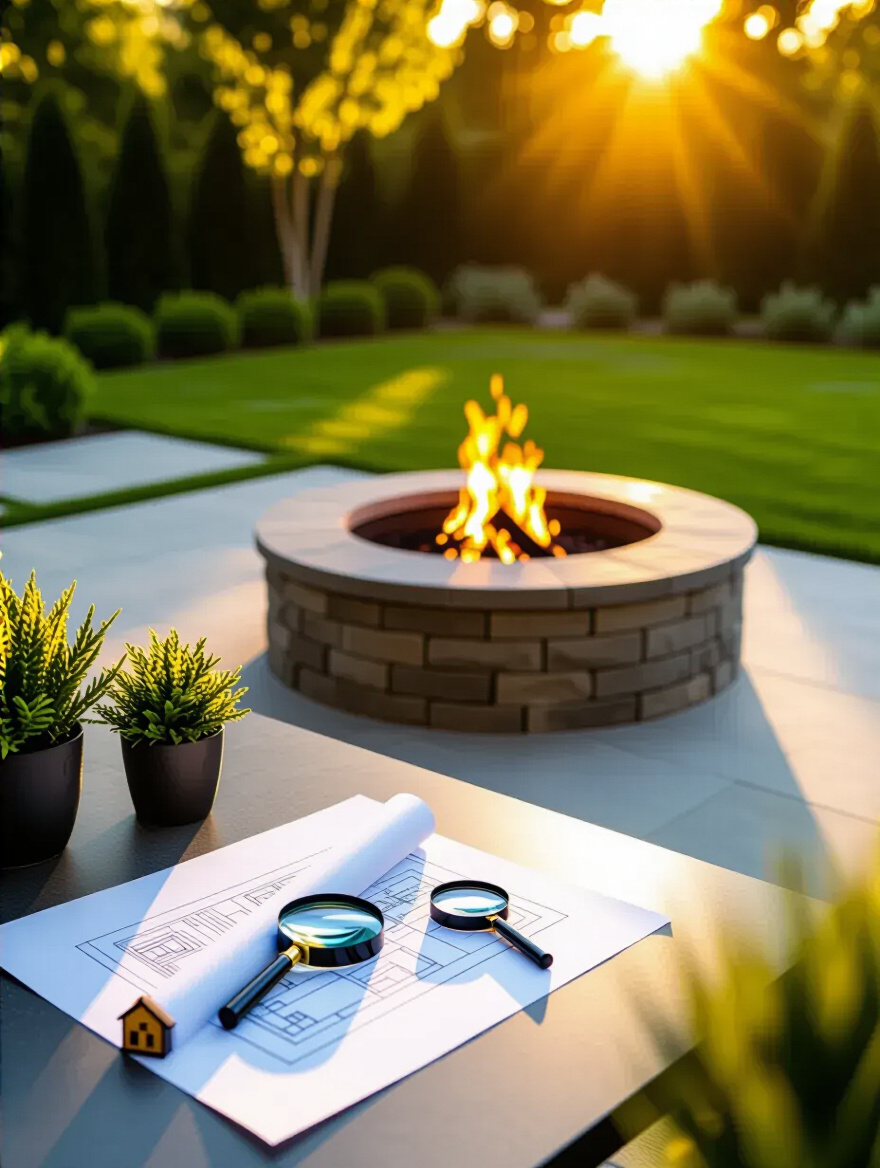
The shortcut I wish I’d known earlier is to call your local fire department’s non-emergency line. Just ask them. “I’m thinking of installing a recreational fire pit. What do I need to know?” They are almost always happy to walk you through the specifics for your area: setback distances from property lines, whether you need a permit for a permanent structure, and any seasonal burn bans. Homeowners’ Associations are another beast entirely; their rules can be even stricter. Getting their guidelines in writing before you begin is non-negotiable. It’s like getting the publishing rights before you print the book.
Don’t let the administrative details dissuade you. Think of it as the necessary, meticulous work of an editor ensuring the final manuscript is flawless and ready for the world to see.
You wouldn’t build a library without knowing if it was for academic research, casual reading, or displaying illustrated folios. The same principle applies here. You have to ask yourself: what is the purpose of this fire? Is it a solitary space for you to sit with a blanket, a book, and a glass of scotch? Is it the epicenter of Socratic dialogues with friends? Or is it for raucous family gatherings where children roast marshmallows into sticky, molten creations?
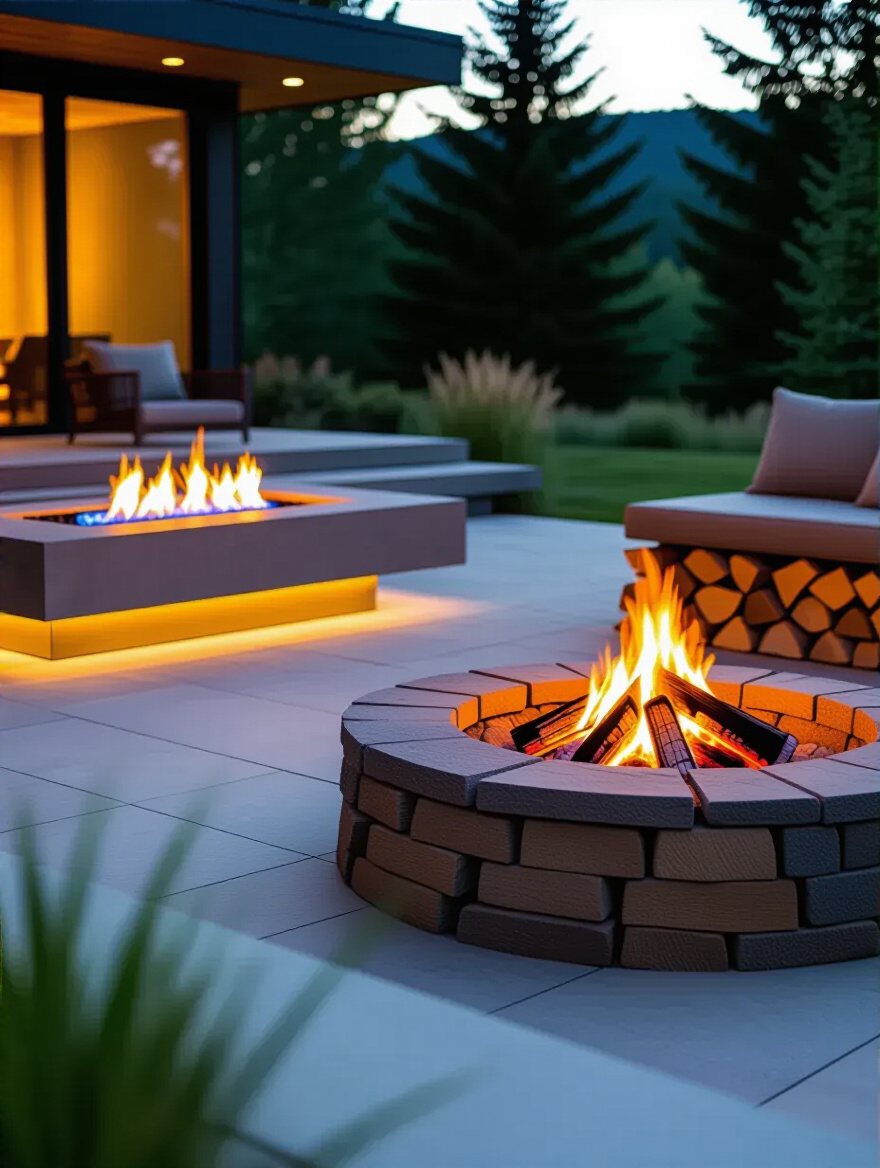
The answer to that question dictates everything, especially your fuel. A wood-burning fire is elemental, primal. It crackles and smells of the forest; it’s the stuff of epic poems and ghost stories told in the dark. But it requires tending, storing wood, and managing smoke. Gas—whether natural or propane—is the modern translation. It offers instant flame with the turn of a knob. It’s clean, controlled, and perfect for the person who wants ambiance without the ritual. It’s the difference between setting type by hand and typing on a laptop. Neither is inherently better, but they serve different temperaments and purposes.
Once you’ve decided on the why, the how becomes much clearer. The soul of the space—whether rustic and wild or sleek and convenient—begins to take shape.
Siting a fire pit is much like placing the most comfortable reading chair in a room. It requires a thoughtful consideration of traffic flow, comfort, and the surrounding environment. You want it to be a destination, a place that draws people in, but not an obstacle that disrupts the natural rhythm of the space.
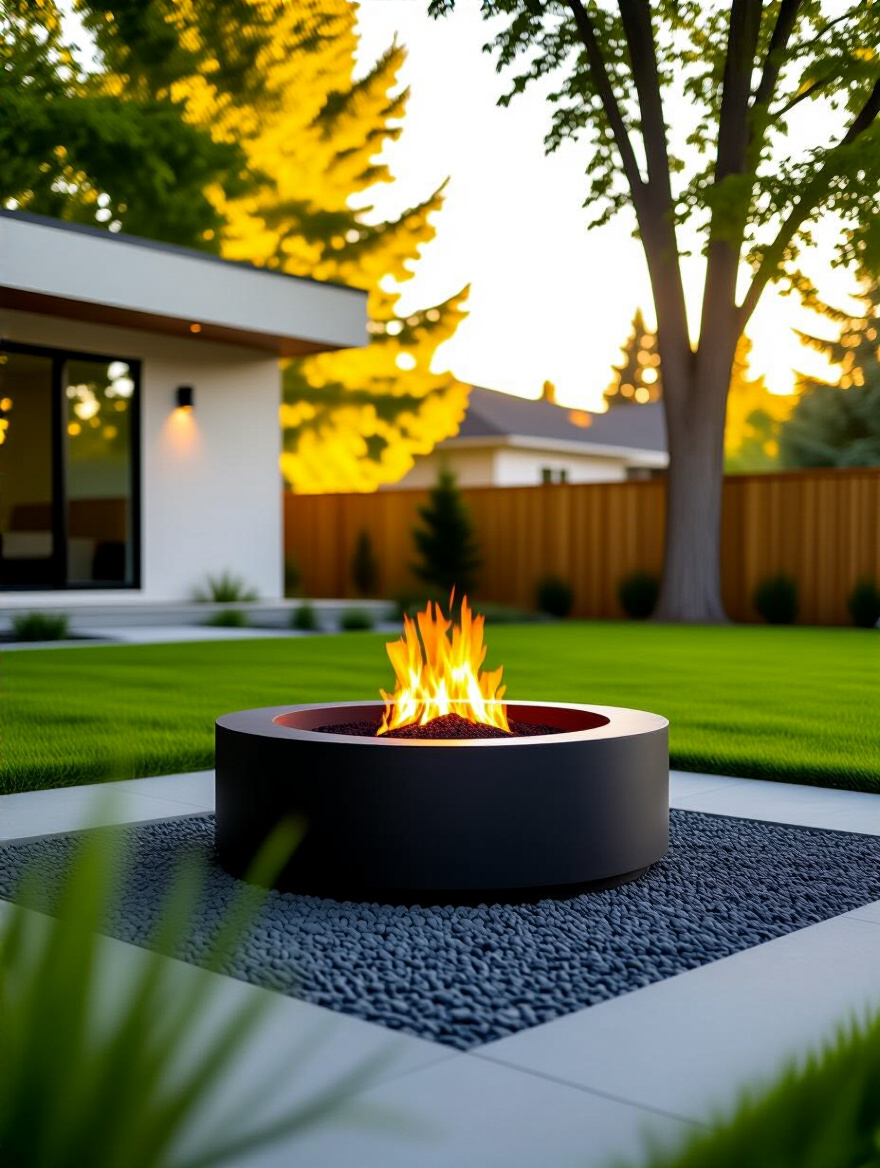
Safety, as always, is the first draft. We’ve already discussed keeping a safe distance from your home and any flammable structures. But the real nuance comes from observing the subtle choreography of your own backyard. Pay attention to the wind. Where does it typically come from? Position your pit so the smoke is carried away from your main seating area and your neighbors’ open windows. I once consulted for a family who perfectly designed their space but placed their pit directly upwind of their patio door. Every fire filled their living room with a smoky haze, turning a charming idea into a recurring nuisance.
The secret is to think of the fire pit as the sun in a small solar system. Arrange your seating—your planets—in a comfortable orbit around it, close enough for warmth and conversation but far enough to allow for easy passage. This arrangement determines whether the space feels intimate and enclosing or open and social.
Let’s be candid: we must speak of finances. Much like building a book collection, creating your fire pit area can range from the cost of a few paperbacks to a full set of rare, leather-bound first editions. A simple steel ring from a hardware store might be your entry point. A custom-built stone hearth with a dedicated gas line is an entirely different investment.
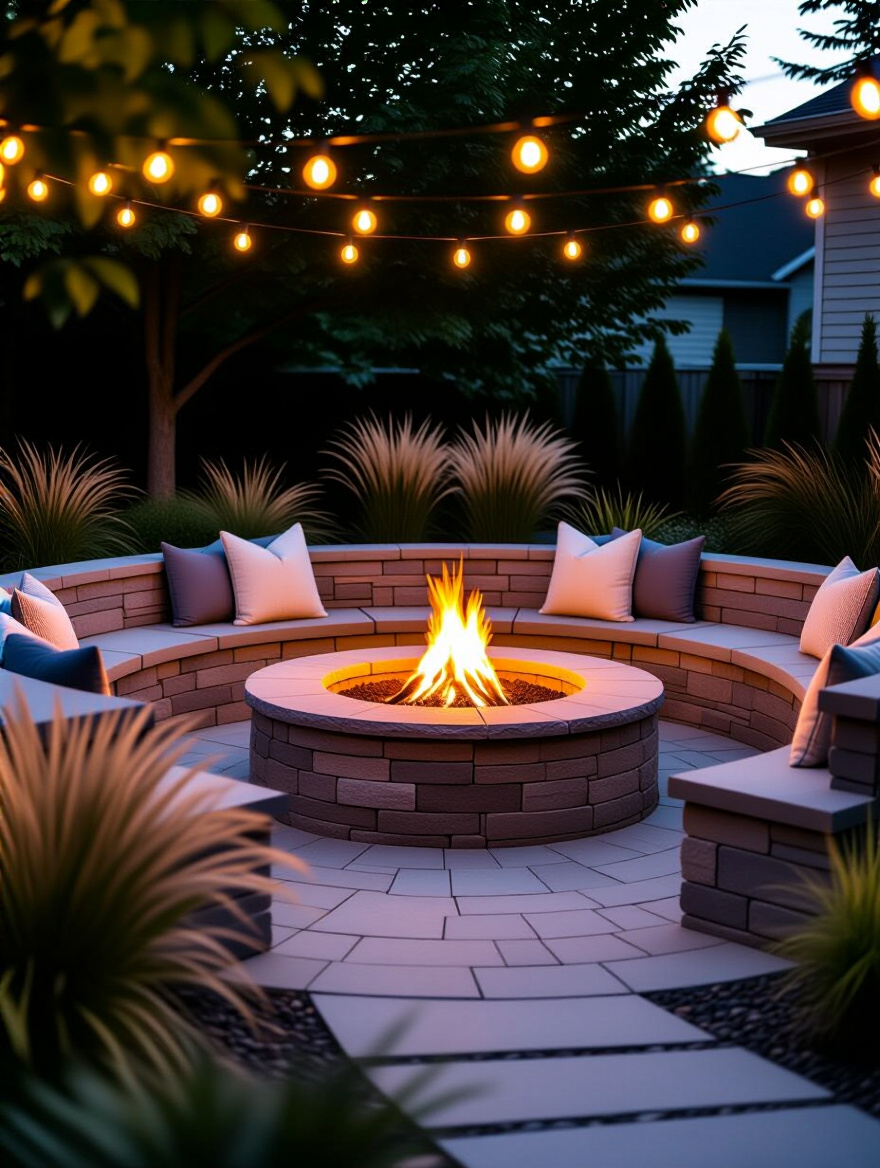
Everyone gets this part wrong: they budget for the fire pit itself and forget everything else. That’s like buying a beautiful hardcover book but forgetting you need a lamp to read it by. The real cost includes the site preparation—the pavers, the gravel—the seating, a protective cover, and essential tools. For gas pits, the professional installation of the line is often the most significant expense. You must account for the entire ecosystem, not just the centerpiece.
My advice is to be honest about your means and your long-term vision. It’s far better to start with a beautiful, well-placed, but modest setup that you can enjoy immediately than to half-finish an ambitious project that languishes for lack of funds. Curation, whether of books or outdoor rooms, is a process. Allow it to evolve.
With a solid plan in hand, we move to the more tangible, creative phase: selecting the vessel for our flame. This is where function and form meet, where the story of your space is written in stone, steel, or concrete. The choices you make here will define the aesthetic and the very character of your outdoor hearth.
The material of your fire pit speaks a language all its own. Cast iron has a heft, a permanence that feels rooted in history. Corten steel, with its evolving russet patina, weathers like a beloved leather armchair, telling a story of seasons passed. Smooth, poured concrete offers a minimalist, almost stoic presence, a blank page upon which the fire can write its narrative. Natural stone feels as ancient as a druid’s circle, connecting your modern backyard to a timeless human tradition.
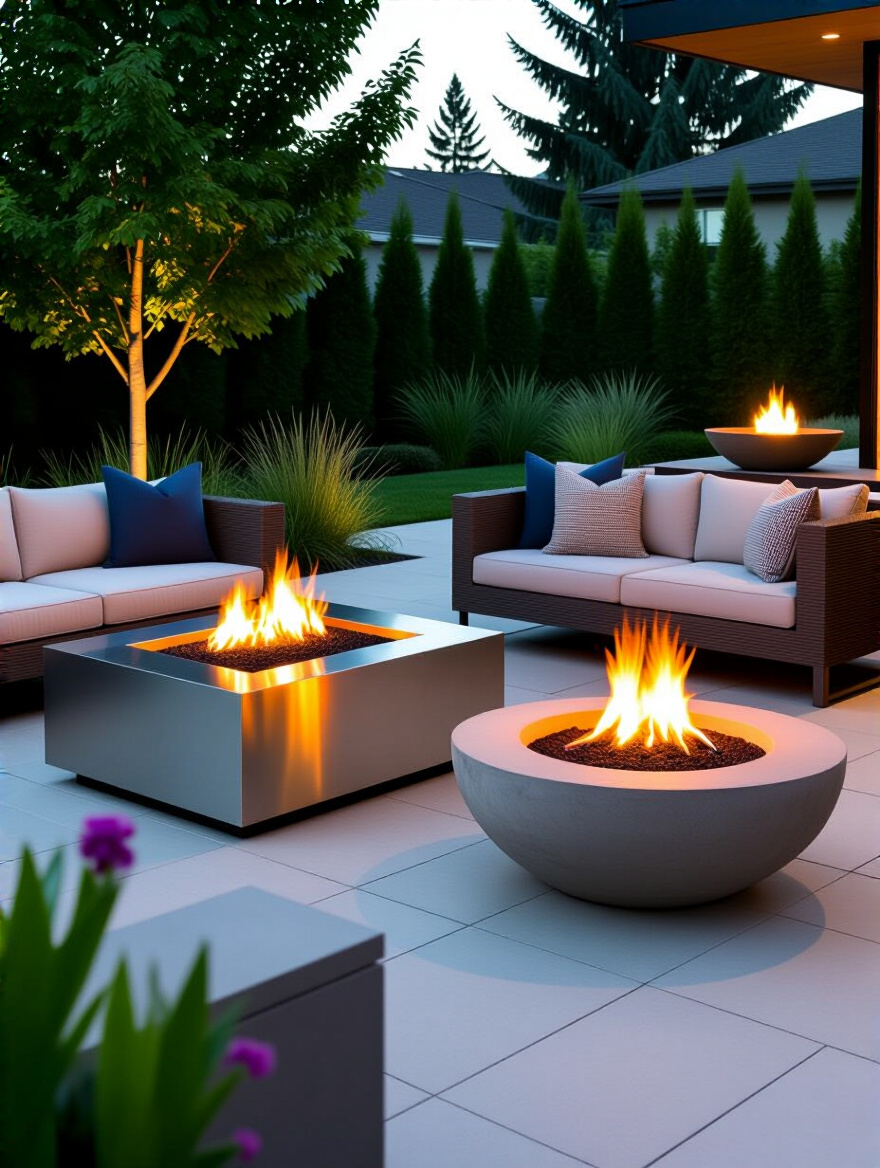
Your climate is the co-author here. In a damp, coastal environment, marine-grade stainless steel or powder-coated aluminum is essential to resist the relentless prose of corrosion. In a place with dramatic freeze-thaw cycles, solid stone or high-quality cast concrete is necessary to prevent cracking. I once saw a beautiful but inexpensive steel pit left out through a New England winter; by spring, it looked like a forgotten relic, rusted and forlorn. The materials must be worthy of their setting.
Think of your home’s architectural style and your garden’s spirit. Is your space a rustic country epic, a sleek modern novella, or a classic, well-ordered novel? The material you choose should feel like a natural extension of that narrative, not a jarringly out-of-place footnote.
This choice is about permanence and utility. Do you prefer a classic you can carry with you, or a reference tome that anchors the entire room? A portable fire pit is the pocket-sized paperback: versatile, affordable, and perfect for smaller spaces or for those who like to rearrange their setting. You can move it to catch the last rays of sun or store it away entirely when you need the space for something else.
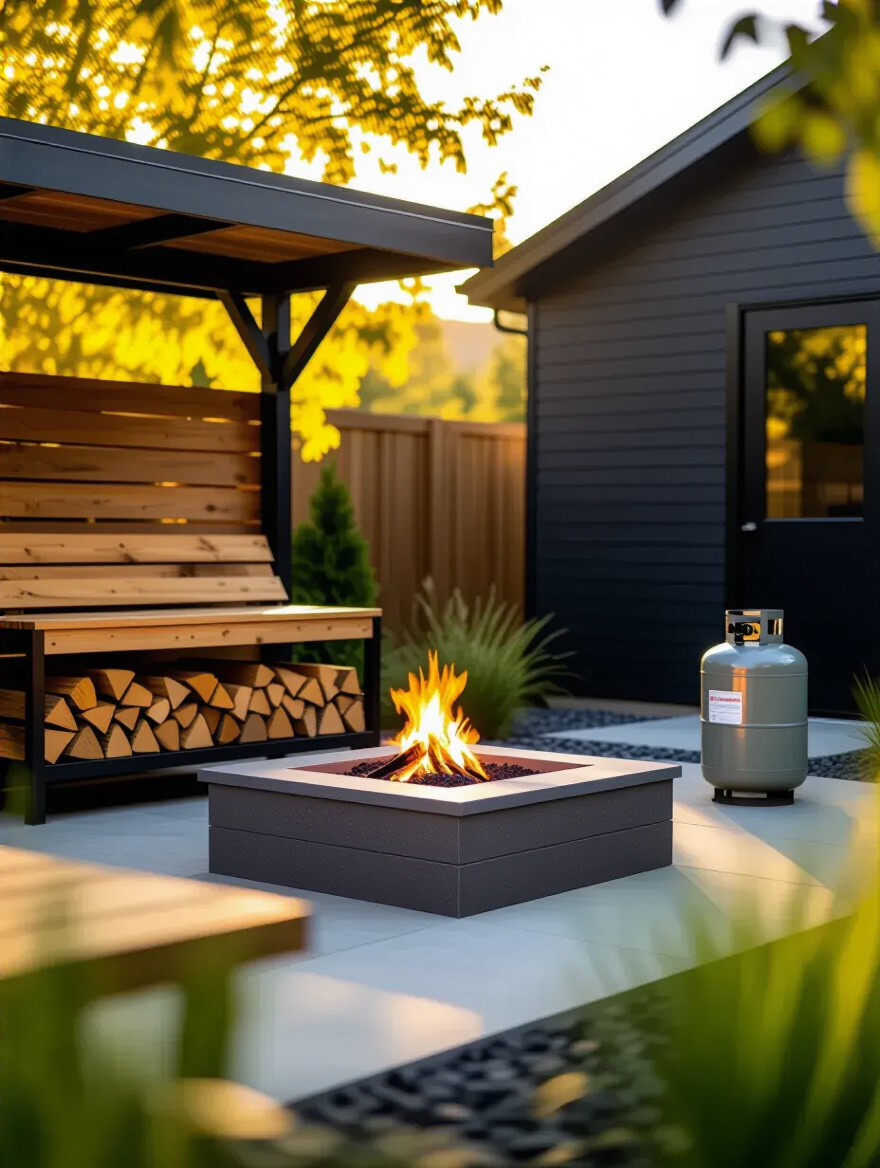
A built-in fire pit is a definitive statement. It is the cornerstone of your outdoor library, a permanent installation around which the rest of the landscape is organized. It integrates seamlessly and can be clad in materials that match your home or patio, creating a powerful sense of cohesion. It declares, “This is a place for gathering.” Then there is the fire pit table, a clever hybrid. It’s a pragmatic solution that combines the function of a coffee table with the ambiance of a fire. It’s perfect for smaller patios where a single piece of furniture must serve multiple roles, providing a surface for drinks or a book when the fire is off.
The best choice hinges on how you live. Don’t build a permanent monument if your life is in flux. But if you are putting down roots, creating a lasting anchor for your home can be a deeply rewarding act.
I am a fervent believer in the satisfaction of doing things oneself. However, I’ve learned there are times to be the author and times to hire a master bookbinder. When your vision involves a permanent structure, masonry, and especially a natural gas line, it is time to call in the artisan. You would not attempt to bind a priceless manuscript with a glue stick and a prayer; do not attempt to run a gas line yourself.
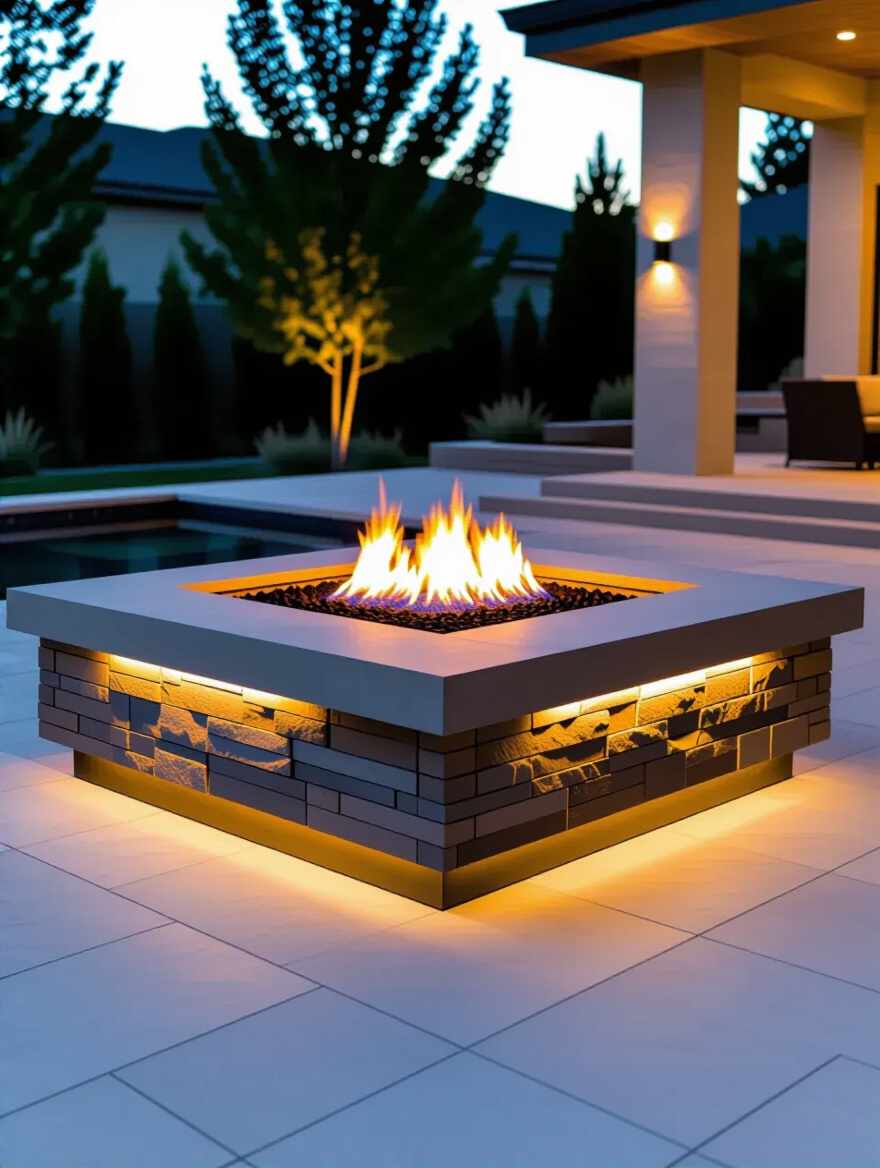
Everyone thinks they’ll save money, but the real story is that a DIY gas installation gone wrong is not a charming quirk; it’s a terrifying hazard. A professional ensures not only that it’s safe and up to code but also that the result is aesthetically flawless. They understand the nuances of proper drainage within the structure, the correct ventilation to ensure a clean burn, and the artistry to make the finished piece look as though it has always been there.
My confession is that I once tried to build a small stone retaining wall myself. The result was… humble. It taught me a valuable lesson: recognizing the limits of one’s own expertise is a form of wisdom. For a complex, built-in fire pit, investing in a professional isn’t an expense; it’s an insurance policy on your safety and your satisfaction.
A fire, much like a good story, needs to breathe. Without a steady supply of oxygen, the narrative becomes smoky, muddled, and inefficient. For permanent fire pits, this is not a metaphorical point. Proper ventilation—typically achieved with vents built into the base of the structure—is crucial for a clean, healthy flame. It allows air to be drawn in from below, fueling the fire and helping to push smoke up and away.
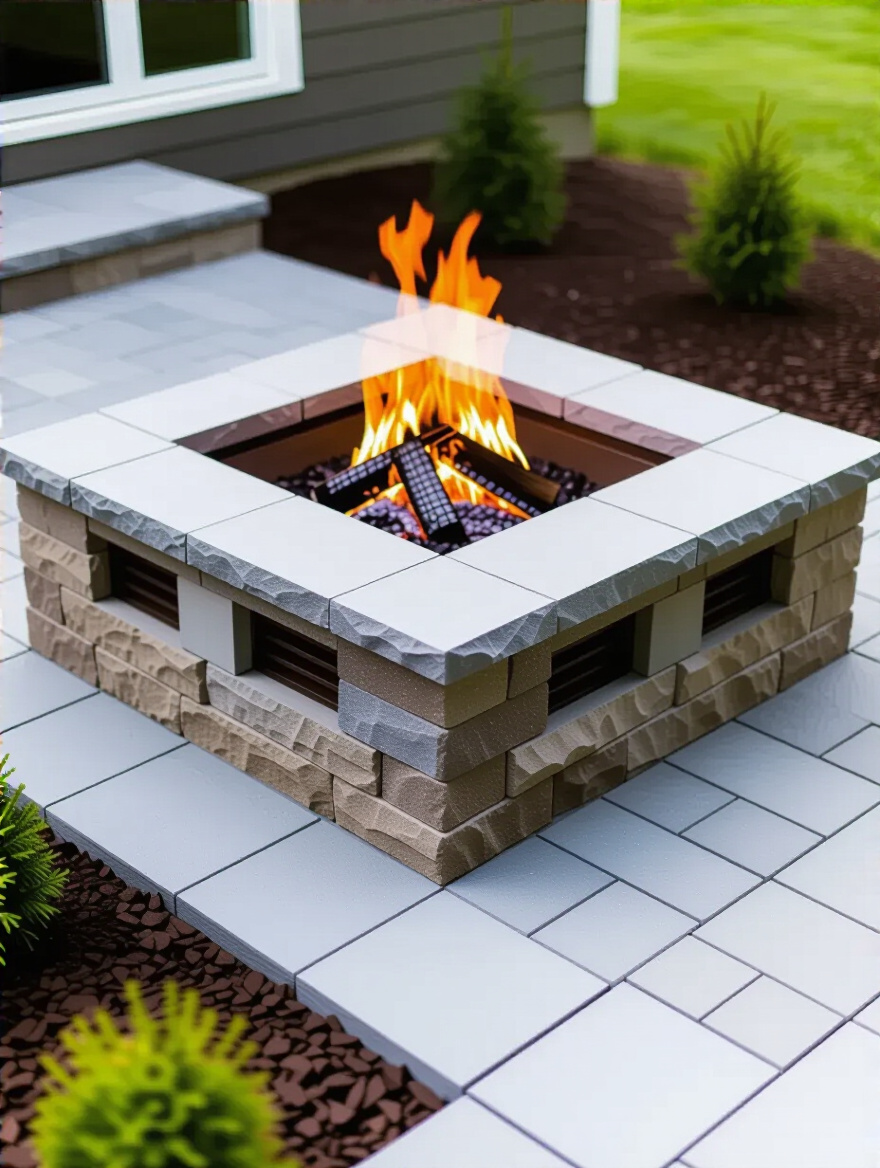
Drainage is the other half of this silent, vital infrastructure. A fire pit that collects water becomes a stagnant pond, breeding mosquitos and slowly degrading the masonry or corroding the metal burner. I’ve seen beautiful stone pits crumble prematurely because water pooled inside, froze in the winter, and expanded, cracking the structure from within. It’s a slow, sad demise that is entirely preventable.
The solution is simple but essential: a layer of gravel at the bottom of the pit and a small, central drain hole. This allows rainwater to seep away into the ground rather than collecting in the vessel. These two elements, ventilation and drainage, are the unsung heroes of a long-lasting and enjoyable fire pit. They are the structural grammar that makes the beautiful prose of the fire possible.
Having constructed the vessel, our attention now turns to its lifeblood: the fuel. The way you store and manage your fuel source is as important as the design of the fire pit itself. It’s the behind-the-scenes library science that makes the entire system function seamlessly and safely.
Managing your fuel source is like managing your ‘to-be-read’ pile: it requires a system to be effective and not become a hazard. Whether you’ve chosen the rustic charm of wood or the clean convenience of gas, safe storage is paramount. The noise everyone hears is about the fire itself; what actually matters is how you handle the fuel when it’s not burning.
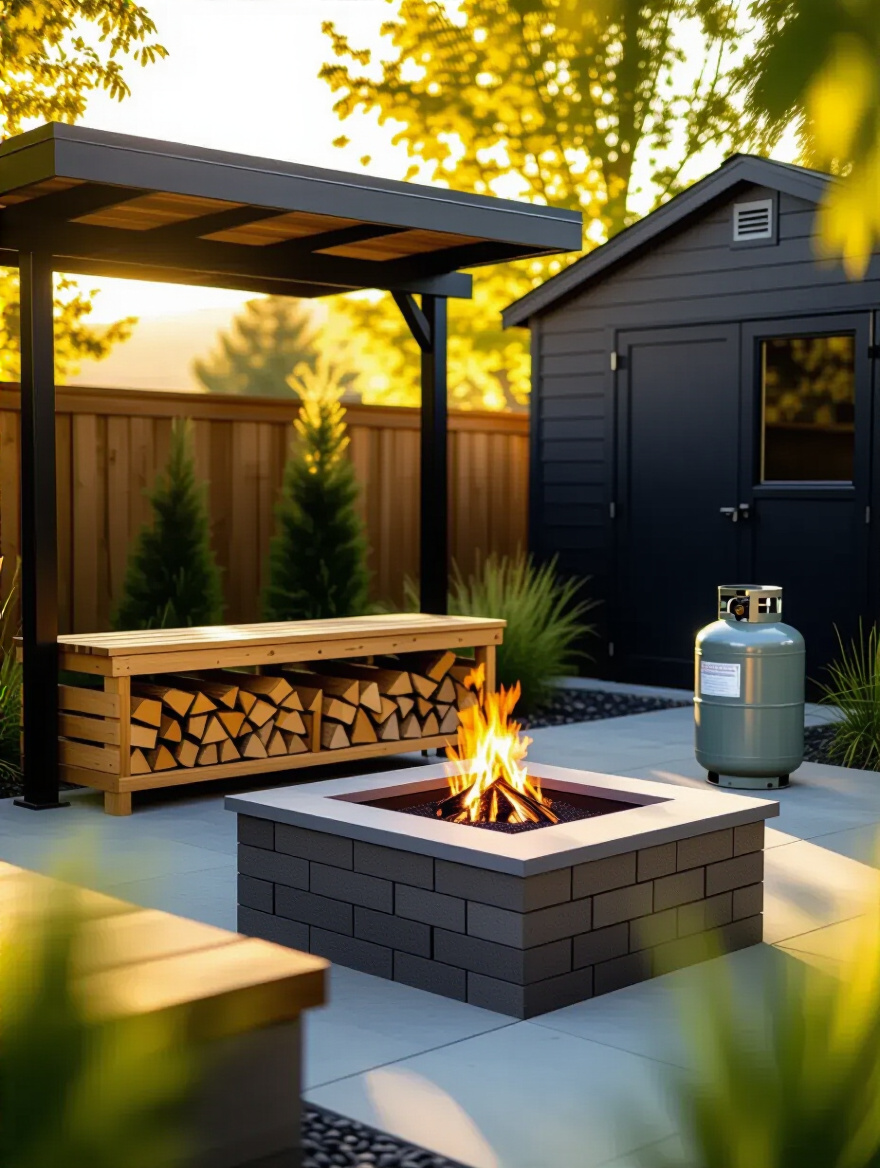
For firewood, the rules are simple but widely ignored. Get it off the ground. Stack it on a rack where air can circulate all around it. And cover the top, but leave the sides open. This allows the wood to season properly and stay dry without getting moldy. Storing it at least 20 feet from your house is not a suggestion; it’s a fire code standard in many places for a reason. For propane, the mantra is “outdoors and upright.” Storing a tank in a garage or shed is one of the most common and dangerous mistakes. A small leak can fill an enclosed space with flammable gas, creating a bomb waiting for a spark.
I used to think storing wood was simple. Then I spent a season trying to burn damp, smoky logs I’d left piled on the ground. It was a frustrating, sputtering mess. Properly seasoned and stored wood is the difference between a cheerful, roaring fire and a churlish, smoldering disappointment. Your future self will thank you for the small effort you put into organized, safe fuel storage today.
Now, we arrive at my favorite part of the process—the art of creating a space that feels not just functional, but magical. The fire pit is the central character, but the supporting cast of seating, lighting, and landscape is what brings the entire scene to life and makes you want to linger for hours.
The seating around your fire is the syntax of your outdoor room. Does it encourage an intimate dialogue for two, a circular council for a large group, or a flexible arrangement for various occasions? The configuration is everything. A fixed, semi-circular stone bench creates a sense of enclosure and permanence, a modern-day exedra for philosophical discussion. A collection of movable Adirondack chairs, on the other hand, offers a more casual, adaptable vibe.
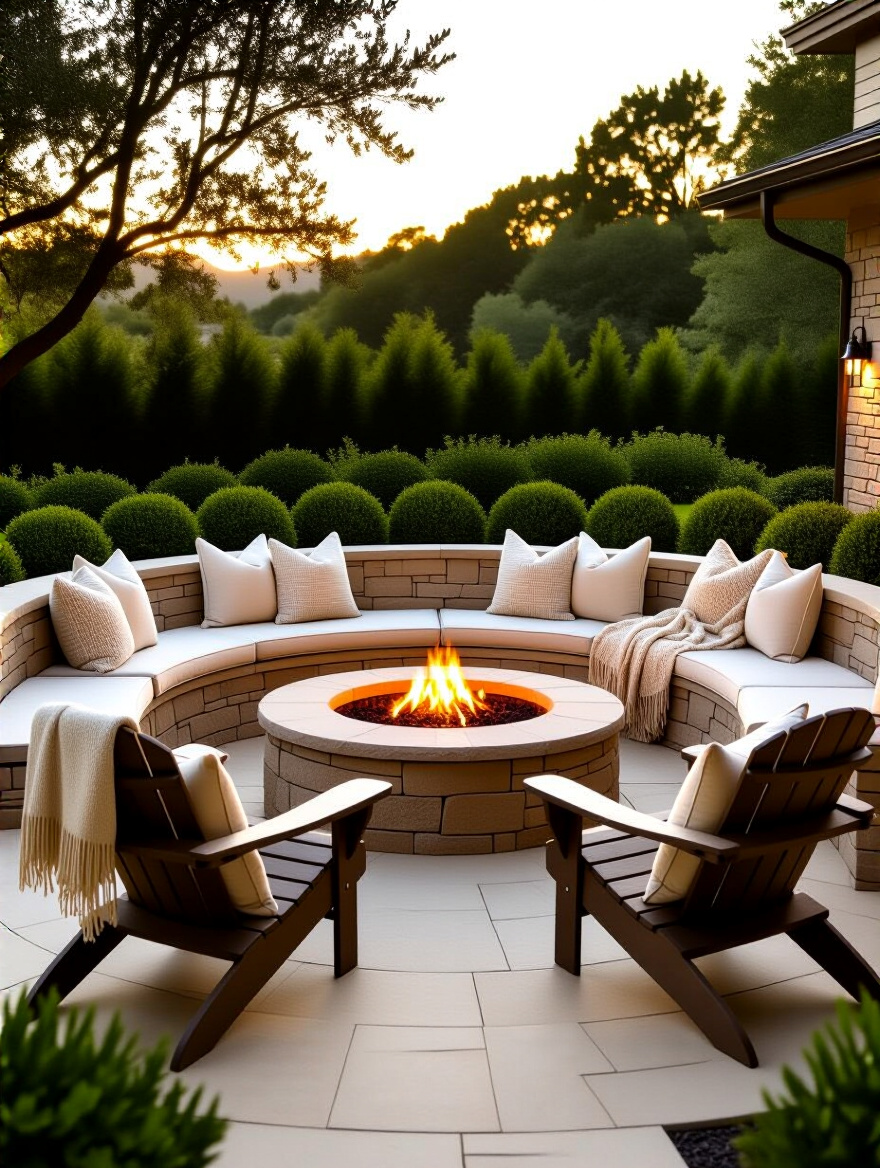
Material durability is key. Furniture near a fire is exposed to more than just the elements; it contends with heat and the occasional airborne ash. Choose materials that can withstand this: powder-coated aluminum, all-weather wicker, or heavy, treated woods like teak or shorea. The real BS everyone sells is “weather-resistant” cushions. Look for fabrics like Sunbrella that are genuinely designed for the outdoors, and even then, storing cushions when not in use will exponentially extend their life.
The shortcut is to think in layers. Start with a foundation of durable primary seating, and then add elements like outdoor poufs or even simple log stools that can be moved around as needed. This flexibility ensures your space can accommodate a quiet evening with a book or a lively gathering with equal grace.
The fire is the protagonist of your evening, but every good story needs supporting light. Over-lighting the area is a cardinal sin; you don’t want a stadium-lit patio that competes with the flame. The goal is to create a soft, layered glow that enhances the fire’s magic rather than diminishing it.
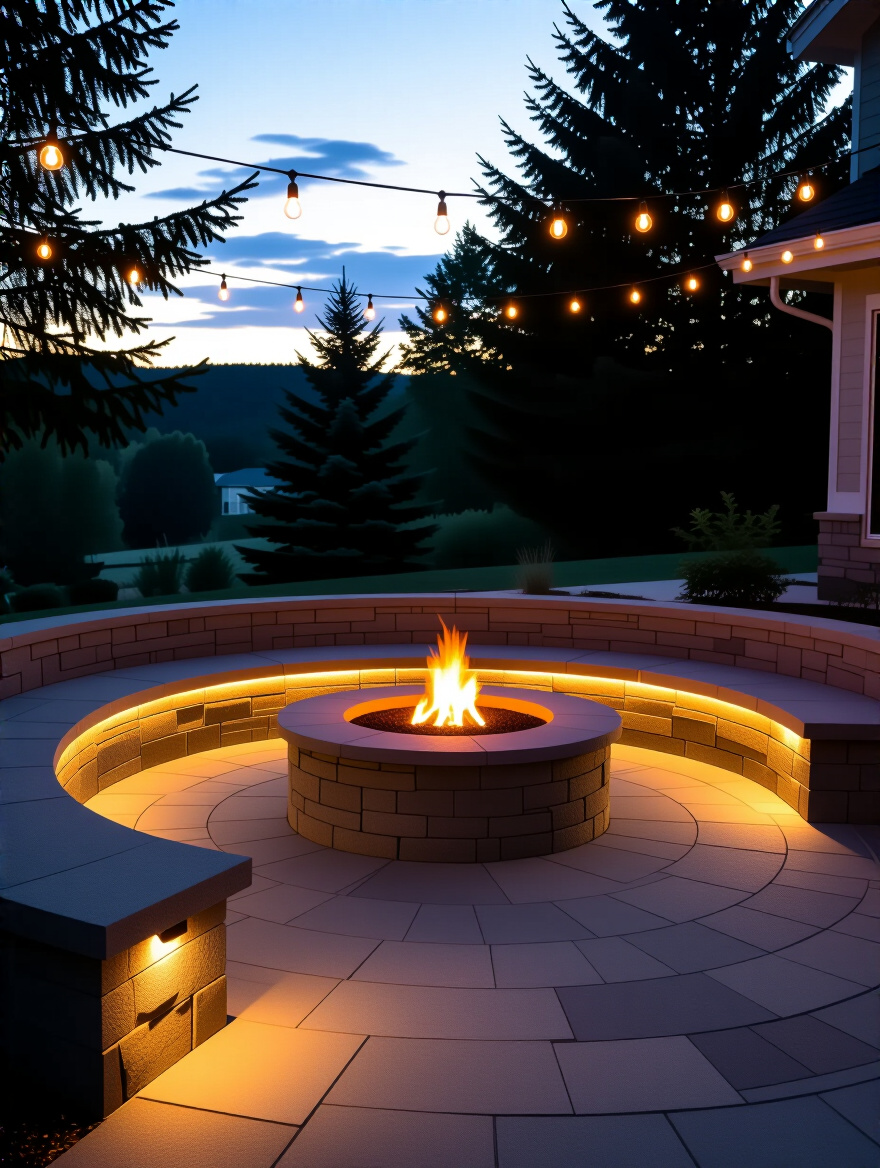
Start with ambient light. This is the general, mood-setting illumination. String lights draped overhead can create a celestial canopy, while solar-powered lanterns placed in surrounding garden beds can offer gentle, scattered points of light. The key is warm-temperature light (around 2700K) that mimics candlelight or the fire itself, creating a cohesive, golden atmosphere. Next, add task lighting where needed. A discreet downlight over a small side table where you place your drink, or subtle step-lights to ensure safe passage along a path—these are practical necessities that should be felt, not seen.
I’ve learned that the most enchanting spaces use light to create mystery and shadow, not to eliminate them. The goal isn’t to replicate daylight. It’s to craft a unique nighttime environment where the fire remains the star, and the surrounding glow feels like a soft, respectful supporting role.
A fire pit plopped in the middle of a lawn can feel like an afterthought. The art is to use landscaping to weave it into the fabric of your garden, making it feel intentional and integrated. Think of plants as the living architecture that defines your outdoor room.
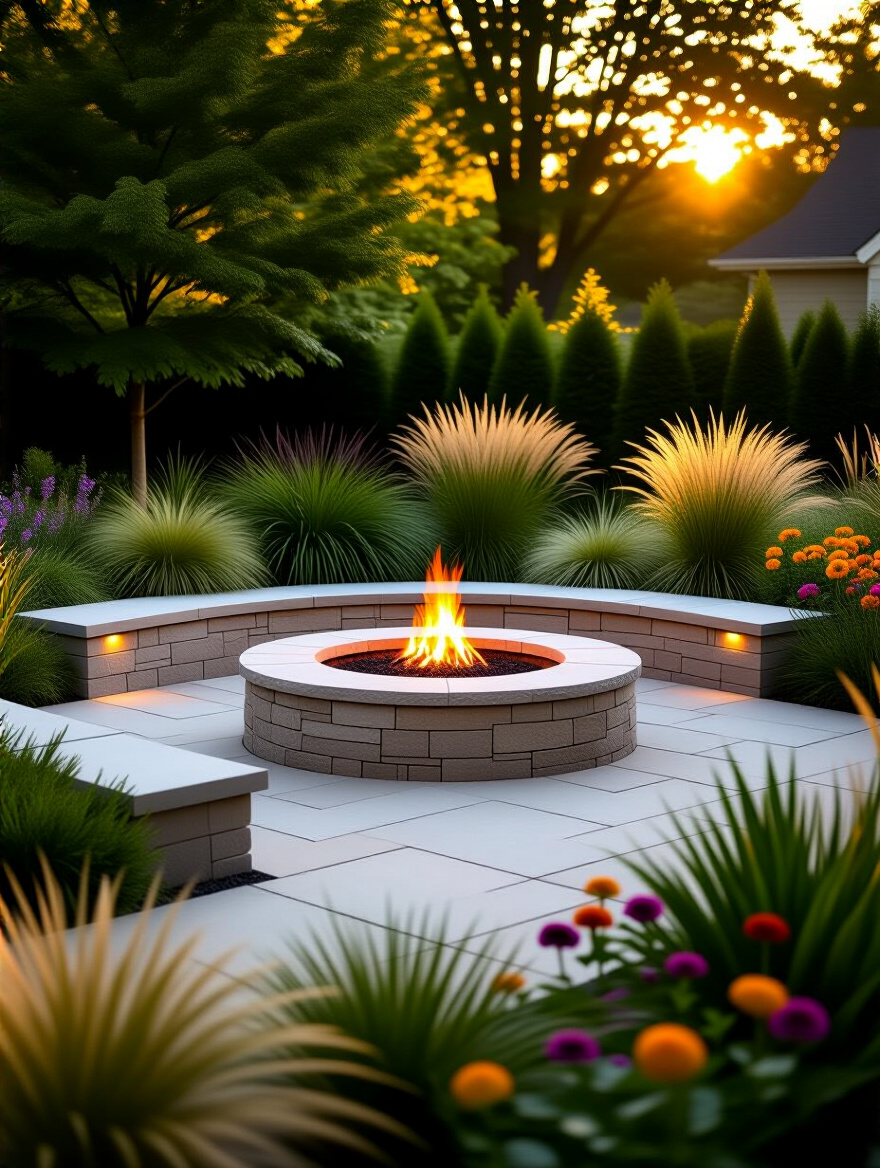
Use low hedges or a border of ornamental grasses to create a soft boundary for the fire pit area, giving it a sense of place. For a more secluded, secret-garden feel, layer taller plants like columnar shrubs or clumping bamboo on the outer perimeter to screen views and create a sense of privacy. Fragrance is another powerful tool. Planting aromatic herbs like lavender or rosemary nearby will release their scent when warmed by the fire, adding another sensory layer to the experience. A client of mine bordered their flagstone fire pit patio with a low wall of creeping thyme, which released a beautiful herbal aroma whenever someone stepped on it.
This is not about elaborate, high-maintenance gardening. It’s about using a few well-chosen plants to soften the hard edges of the stone or metal, blur the lines between the constructed and the natural, and create a space that feels like a true sanctuary.
This is where you infuse the space with your own intellectual and aesthetic identity. Think of it as adding the marginalia, the personal notes and underlinings that make a book uniquely yours. A fire pit area should reflect the people who gather there.
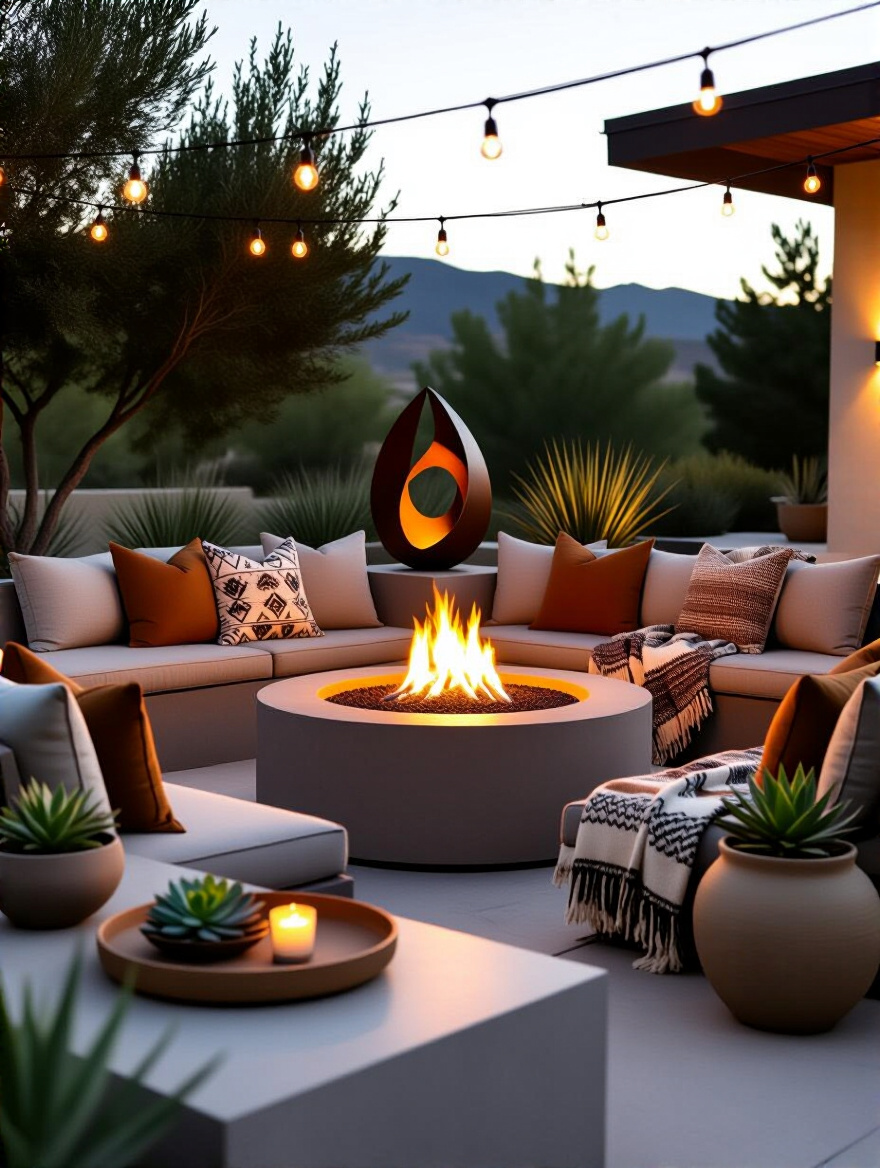
This could be as simple as a set of beautifully crafted roasting sticks or a unique log holder that is both functional and sculptural. Perhaps it’s a stack of weathered terracotta pots with hardy succulents, or a small, discreet outdoor speaker for playing a curated playlist of quiet, contemplative music. For me, a small, weatherproof side table is essential—a place to rest a book and a warm drink. One of my most memorable client projects involved incorporating a weatherproof poetry stone, engraved with a favorite line from Mary Oliver, into the surrounding patio.
Don’t clutter the space. The goal is curation, not collection. Choose one or two meaningful accents that add to the story of the space without overwhelming it. These personal touches are what elevate a well-designed area into a place that feels like home.
We’ve built the structure and set the stage. Now we look inside the hearth itself. The media you choose to fill your fire pit—the “stuff” the flames emerge from—is not merely filler. It’s the final stylistic choice that shapes the very character of the fire.
For gas fire pits, the choice between rustic lava rock and shimmering fire glass is like choosing between writing in earthy prose or crystalline poetry. Both tell a different story with the flame. Lava rock is porous, dark, and organic. It creates a more natural, primal look, as if the flames were springing directly from the earth. It absorbs and radiates heat beautifully, creating a deep, resonant warmth.
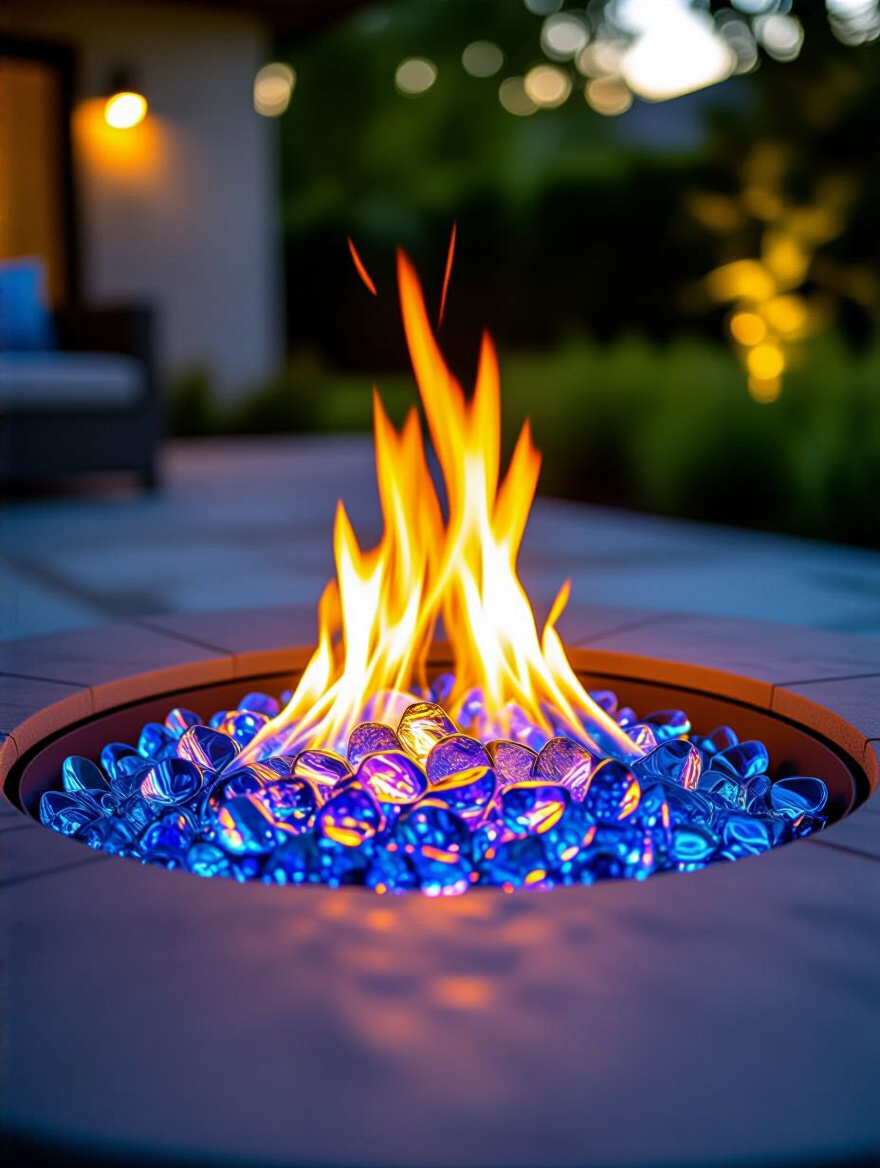
Fire glass, on the other hand, is pure spectacle. It’s tempered glass tumbled into jewels of color that sparkle and reflect the light. The flames appear to dance on a bed of liquid light, creating a modern, mesmerizing effect. It’s clean, doesn’t produce soot, and comes in a universe of colors to match any design palette. And while some say it’s just decorative, that’s not the whole story. The glass heats up and radiates warmth outward just as effectively as lava rock.
You can even combine them. I often recommend a base layer of less expensive lava rock for volume and heat distribution, topped with a glittering layer of fire glass. This is the practical shortcut: you get the stunning visual effect without having to fill the entire pit with the more expensive glass. Ultimately, the media you choose is the final brushstroke that defines the fire’s personality.
The story doesn’t end once the fire pit is built. A well-loved space is a well-tended one. This final section is about the simple rituals of care and the intentional practices of use that ensure your outdoor hearth remains a source of joy for years, not just a single season.
Tending to a fire pit is like caring for old books. A bit of regular dusting and maintenance prevents the slow, insidious creep of decay. For a wood-burning pit, the single most important thing you can do is remove the ash regularly. Everyone makes this mistake: they let the ash sit. But ash is hydrophilic—it soaks up moisture from the air and holds it against the metal or masonry of your pit, turning into a corrosive, acidic sludge.
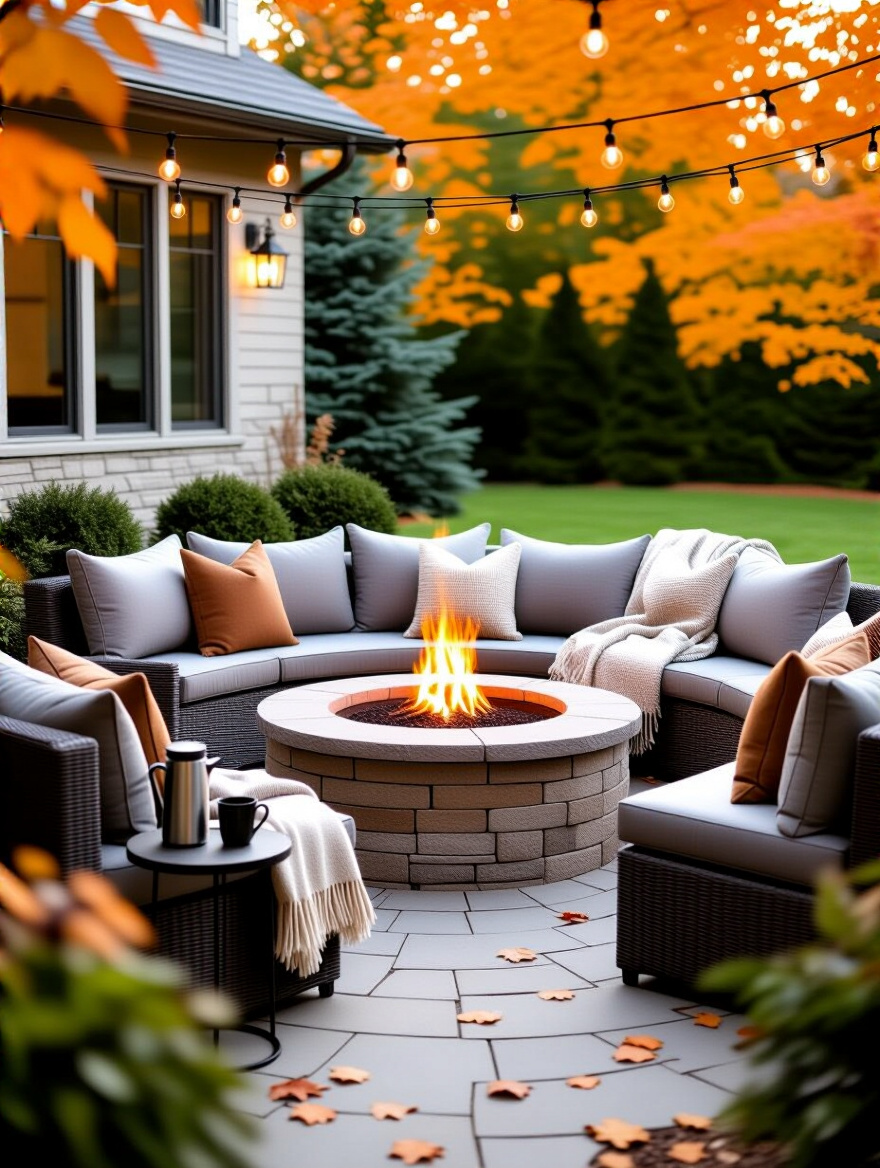
My pet peeve is seeing a beautiful steel fire pit with a permanent mound of old, damp ash in it. That is a death sentence for the metal. Once the pit is completely cool (give it at least 24 hours), scoop the ash into a metal bucket and dispose of it. For gas pits, the maintenance is simpler: keep the burner holes clear of debris and gently clean the fire media once a season to remove dust and soot that can affect the flame quality.
This isn’t arduous. It’s a five-minute ritual that will literally double the life of your fire pit. Think of it as a small act of respect for a feature that brings so much pleasure.
A good cover is the slipcase for your fire pit. It is the single best investment you can make to protect it from the elements. Rain, snow, sun, and falling leaves are all engaged in a slow-motion effort to dismantle and degrade your beautiful outdoor feature. A high-quality, waterproof, and UV-resistant cover stops them cold.
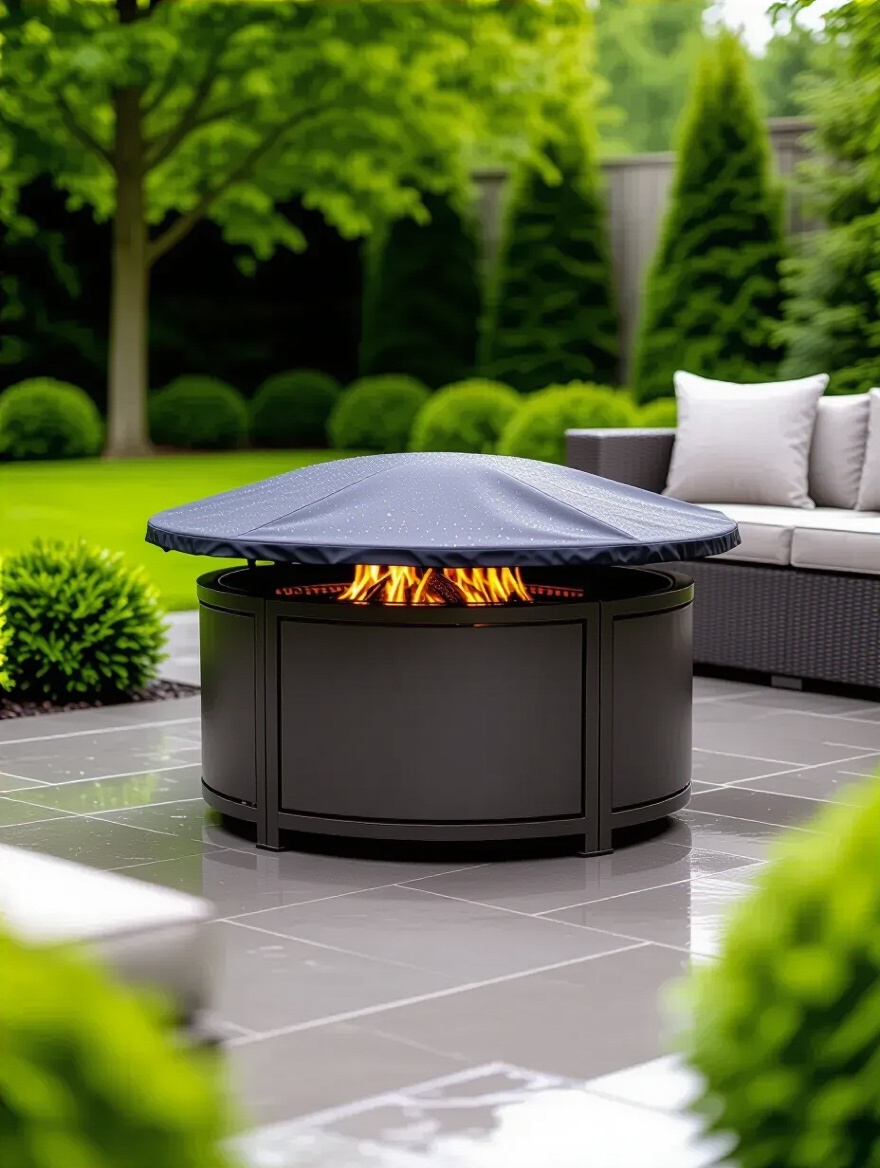
I used to think any old tarp would do. I was dead wrong. A cheap cover will photodegrade in a single season, tear in the wind, and often trap moisture underneath, which can be worse than no cover at all. Look for a cover made from heavy-duty polyester with a waterproof backing, secure straps or a drawstring to cinch it tight, and—this is the pro tip—vents to allow for air circulation and prevent condensation.
Measuring your fire pit and buying a cover that fits snugly is crucial. A well-fitted cover sheds water like a duck’s back and protects your investment completely, ensuring that when you’re ready for a fire, your pit is clean, dry, and ready to go.
Accessories are your reading glasses, your favorite bookmark, your highlighting pen. They are the small tools that make the entire experience easier, safer, and more enjoyable. They are not noise; they are essentials.
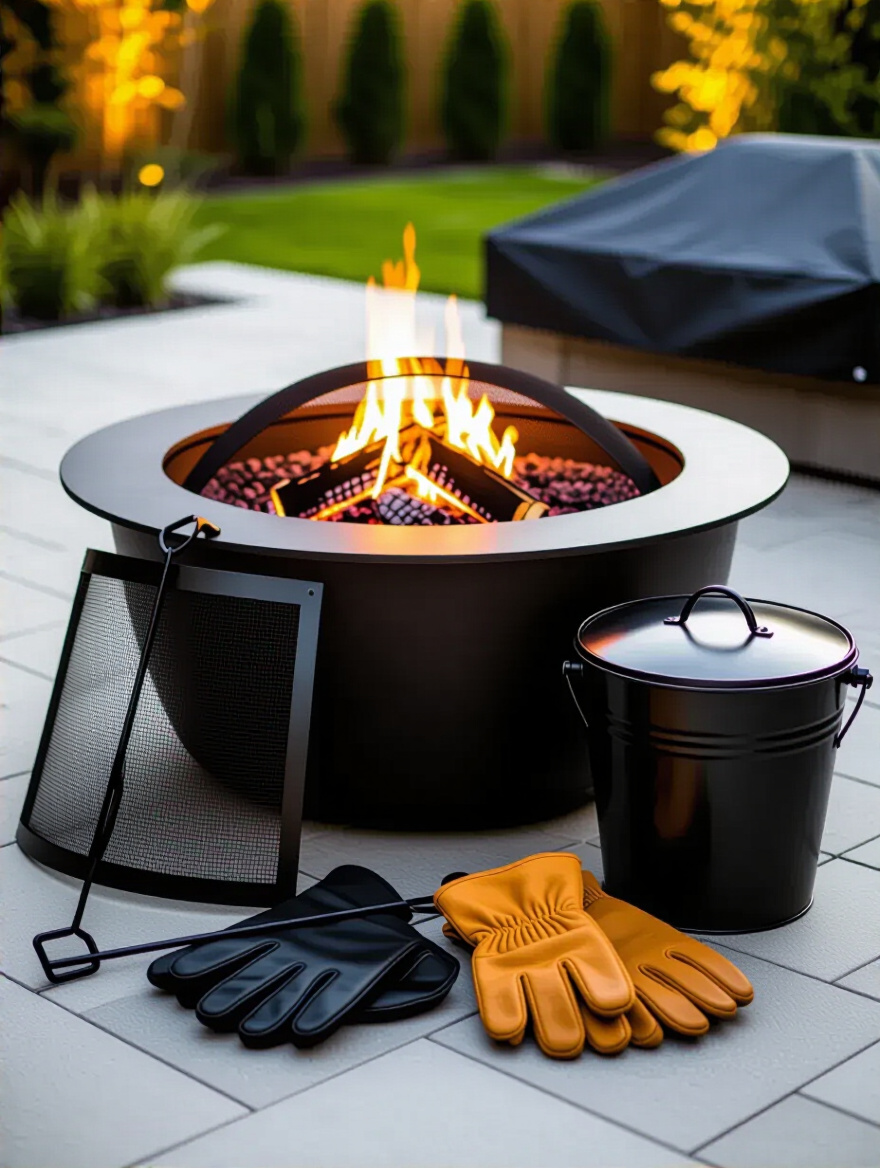
The non-negotiables are a spark screen and a set of long-handled tools. A spark screen is vital for wood-burning pits, especially on breezy nights or if you have children or pets. It contains the embers that would otherwise leap out and potentially scorch your deck or lawn. The tools—a poker, tongs, a small shovel—allow you to manage the fire from a safe distance, repositioning logs to improve airflow or banking the coals at the end of the night. For safety, a pair of heat-resistant gloves is a wise addition.
I learned the hard way that poking a fire with a found stick is a charmingly rustic but ultimately ineffective and risky way to manage a fire. Investing in a proper, sturdy set of tools made all the difference. Keep them in a dedicated spot, perhaps a weather-resistant box near the pit, so they are always at hand when you need them.
A great library isn’t just for cold winter nights, and your fire pit shouldn’t just be for perfect summer evenings. The true magic of this space is unlocked when you see it as a four-season destination. With the right planning, it can be just as enchanting in the crisp air of autumn or the quiet chill of winter.
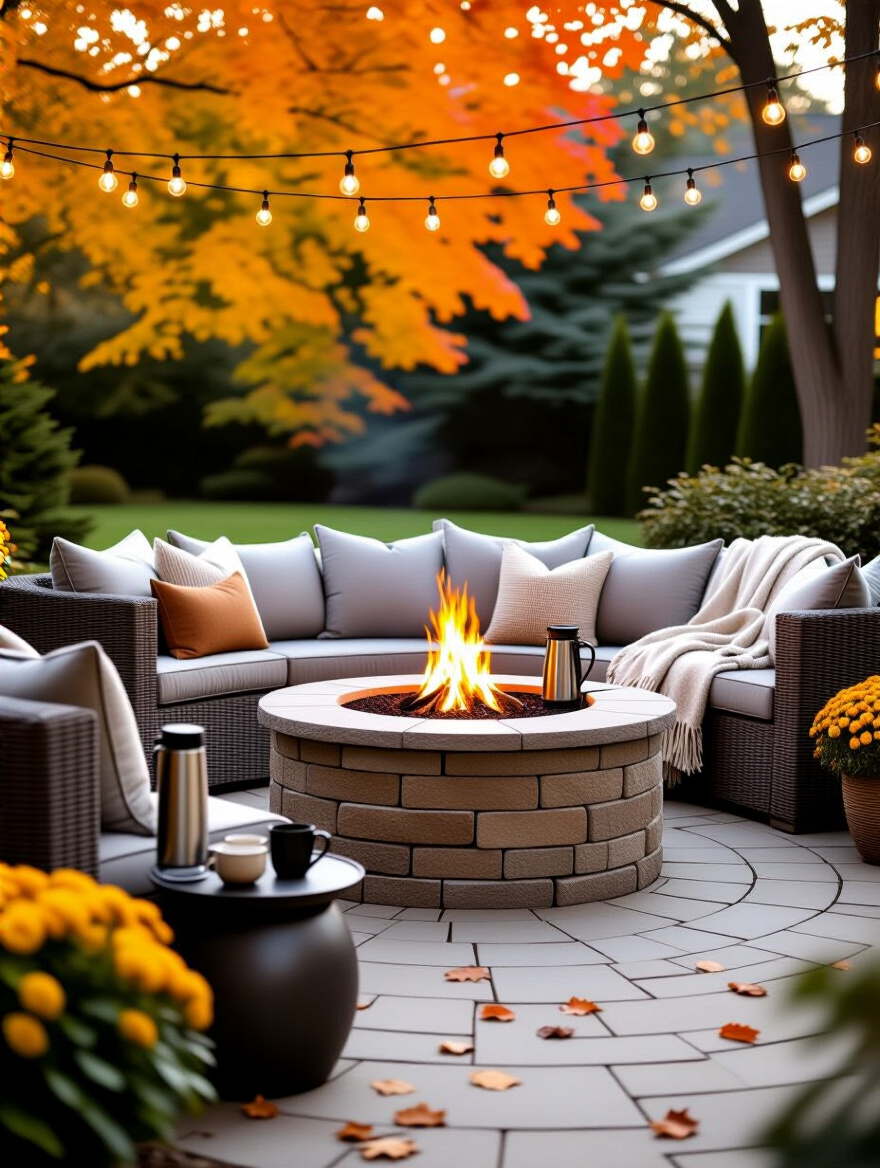
Keep a basket of warm blankets nearby. Serve hot cider instead of iced tea. In winter, after a light snow, there is nothing more magical than a fire pit glowing in a pristine white landscape. Create your own traditions. Perhaps it’s an annual telling of a favorite ghost story in October, a reading of a solstice poem in December, or simply a weekly ritual of unplugging from all screens and reconnecting around the flame.
This is how you maximize your investment. It’s not a piece of furniture; it’s a stage. By actively planning to use it, by creating small rituals and themed gatherings, you transform it from a static object into a living, breathing part of your home and your story.
We began with the image of a reader seeking solace by a fire, and we’ve traveled through the entire grammar of creating such a space. We’ve seen that building an outdoor hearth is about more than stone and flame. It is an act of placemaking, of carving out a small piece of the world dedicated to warmth, reflection, and connection. From the careful groundwork of safety and planning to the artful touches of light and landscape, each step is a word in the story you are writing for your home.
The crackling fire is a direct link to millennia of human history, to an unbroken chain of ancestors who also gathered in the dark to share tales, seek comfort, and stare into the flames in quiet contemplation. In creating your own, you are not just adding a feature to your backyard; you are building a sanctuary for your interior life to spill outdoors. You are making a space for stories. Now, go ignite your own.